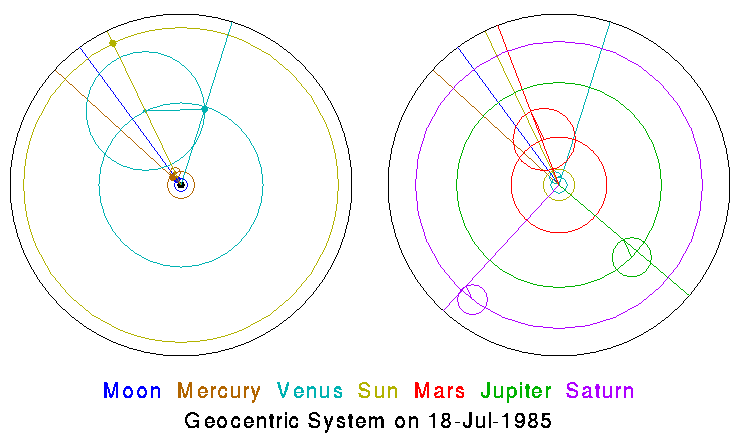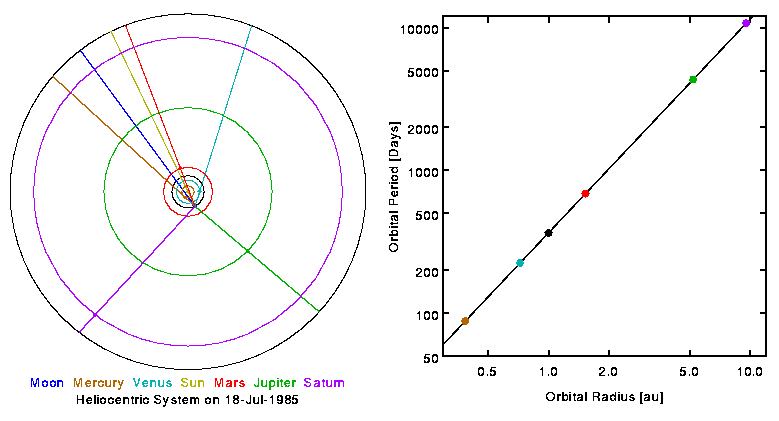
In ancient times the solar system was thought to be the whole Universe, so the study of planetary motions was cosmology. The planets are wandering stars, that move around the constellations defined by the fixed stars. To the ancients, the planets were the Sun, the Moon, Mercury, Venus, Mars, Jupiter and Saturn. While the overall motion of the stars and planets is from East to West (due to the rotation of the Earth), the planets move from West to East through the fixed stars. The Moon's motion "upstream" against the rotation is the fastest, and as a result it takes the Moon 24.83 hours to go around the sky so the average interval between Moon rises is 24 hours and 50 minutes. The Sun takes 24 hours to go around the sky, while the fixed stars take only 23 hours and 56 minutes (the sidereal day).

The planets other than the Moon and Sun generally move West to East through the stars, but occasionally stop and move in the opposite direction (retrograde motion). In order to explain the retrograde motion of the planets, the geocentric model of the Solar System shown above puts the planets on small circles called epicycles. The center of the epicycle always moves West to East (counterclockwise on the picture) along a big circle known as the deferent, and the planet always moves counterclockwise on the epicycle, but the the combined motion leads to periods of retrograde motion when the planet is closest to the Earth.
This model generally led to reasonable predictions of planetary positions, but it has several unexplained coincidences: the centers of the epicycles for Mercury and Venus always line up with the position of the Sun, and the lines from the epicycle center to the planet for Mars, Jupiter and Saturn also line up with the Sun. Thus there are 6 different angles that just happen to always be the same. Many diagrams of the Ptolemaic system to be found on the WWW get this wrong, but Figure 2.19 of Zeilik and Gaustad (2nd edition) gets it right. This kind of unexplained coincidence is often a clue that a better model exists: for example, the equality of the acceleration of gravity for all materials led Einstein to a geometric model for gravity. We do not know what led Aristarchus of Samos to propose a heliocentric model. Copernicus explained the equality of these angles with the heliocentric model of the Solar System shown below.

In the heliocentric model the 6 angles that just happened to always be the same in the geocentric model are all a reflection of the motion of the Earth around the Sun. This is a considerable simplification of the model. A further advantage of the heliocentric model is that the distances of the planets are specified by the sizes of their retrograde loops. A small retrograde loop means a large distance from the Sun. Thus the sizes of the orbits of the planets (relative to the Earth-Sun distance defined to be 1 astronomical unit [1 au]) are known, and we can discover a relation between the orbital period and the orbital radius (P[in years]2 = R[in au]3) that is shown in the graph on the right in the picture above. This relation was discovered by Kepler, and is his Third Law of planetary motion. Kepler's first two laws deal with the elliptical shape of the planetary orbits, which is not shown in either model above. Both Ptolemy and Copernicus introduced additional complications to deal with the effects of orbital eccentricity but these complications do not favor one model over the other.
Tycho Brahe favored a geocentric model because he could not see the parallax of the fixed stars. Tycho proved that the stars would have to be more than hundreds of times further away than the most distant known planet of the time, which was Saturn. But this parallax or retrograde motion of the stars is very small because the stars are actually much further away, so the parallax was not seen for more than 200 years after Tycho. The realization that the Sun is a star and that the stars are millions of times further away than the planets took many years. Bradley discovered the abberation of starlight, which is 30 times larger than the largest parallax, roughly one century after Tycho, and this firmly established that the Earth was moving around the Sun. The parallax of stars was finally seen another century later.
Tutorial:
Part 1 |
Part 2 |
Part 3 |
Part 4
FAQ |
Age |
Distances |
Bibliography |
Relativity